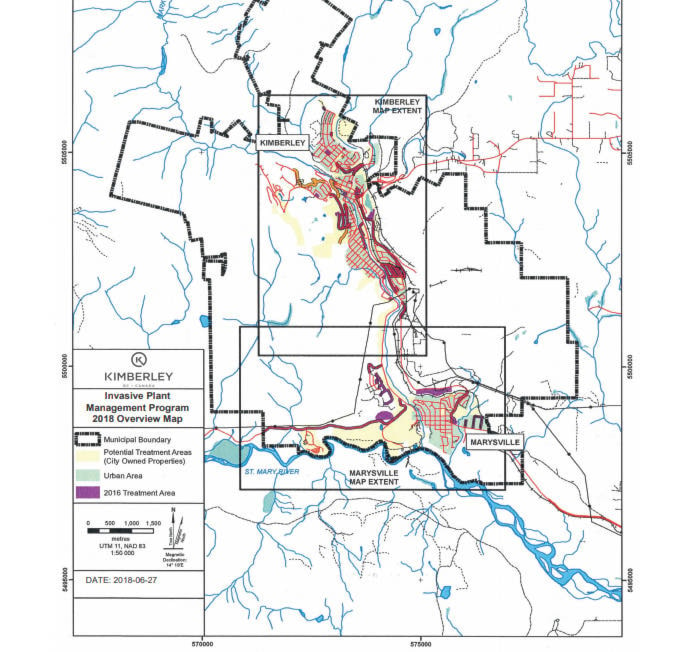The City of Kimberley has released an update on the Invasive Plant Management Program that is currently ongoing throughout the City.
Maple Leaf Forestry (MLF) was awarded the contract to treat Kimberley’s invasive plants through a competitive bidding process and are the same contractor that was used in 2015 and 2016. In 2017 the contract was awarded to the Spectrum Resource Group.
An invasive species is an organism (plant, animal, fungus or bacterium) that is not native and has negative effects on the economy, environment, or health. Invasive plants and animals are the second greatest threat to biodiversity after habitat loss.
All landowners/occupiers in the Province of B.C. have legal responsibility to control provincially and regionally listed noxious weeds. This is legislated through the B.C. Weed Control Act and Regulations.
At a regular Council Meeting on Monday, Manager of Operations Chris Mummery explained that Town Site, Gerry Sorensen Way, Rails to Trails and the Downtown area have been treated thus far. The contractor is currently working their way through the lower Blarchmont and Chapman Camp area and will soon be targeting Marysville.
Councillor Nigel Kitto says there has been some concern among residents with regards to the chemicals used in the process.
Mummery says that MLF will change the product they use depending on the time of year, as different products are more effective at different times and in different locations.
The herbicide products used by MLF to treat the plants are Clearview, Grazon XC, Milestone, RoundUp, Weathermax, Lontrel 360 as well as Lontrel XC. Clearview was chosen as the preferred herbicide for the majority of the infested areas because it does not kill established native grass species.
Councillor Kent Goodwin also asked about the time frame for the treatment, stating that the process started late.
Mummery says that despite the later than intended start, the treatment process is effective well into the fall.
“The City of Kimberley and its contractors give careful consideration when determining the best-suited approaches for treating invasive plant species in Kimberley,” explained Mummery in an email to the Bulletin. “These approaches are rooted in the principles of integrated pest management, which include the selection of suitable treatments for the invasive plant species of concern at the lifecycle stage of those plants during the treatment period.”
He adds that different invasive species warrant different treatment approaches based on their lifecycle stage and their attractiveness to pollinators.
“The integrated pest management approaches that are being applied in Kimberley at this point in the summer have been selected to effectively reduce invasive plant populations as well as to protect other environmental and societal values,” Mummery explained. “One specific example is the treatment of blueweed, which has highly attractive flowers to pollinators like bees.
The treatment approach for blueweed currently involves cutting and disposing of the flowering plant stalks to both reduce the source of blueweed seeds and remove the attractive flowers for pollinators, prior to spot treatments using herbicide to kill the leaves and roots of each plant.
“The success of Kimberley’s Invasive Plant Management program during any period in the growing season relies on the successful application of integrated pest management principles and best management practices to protect other values,” said Mummery. “The City and its contractors have been doing [so] and will continue to do in the effort to reduce the presence of invasive plants in Kimberley.”
